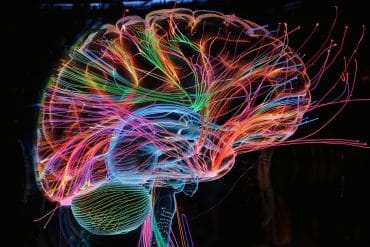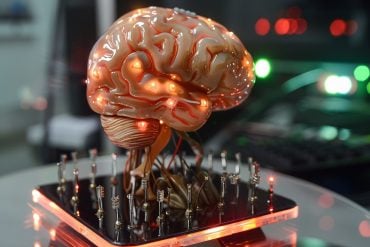Summary: A new study provides insight into the neurobiology behind the motivation to be active.
Source: King’s College London.
Researchers at King’s College London and the Francis Crick Institute have discovered a type of brain cell that prevents mice from being overly immobile. The research provides insight into the brain circuits underlying what motivates us to be physically active.
The cells, called GAD65 neurons, are located in the mouse equivalent of the human lateral hypothalamus. This crucial part of our brain regulates body processes including sleeping and waking, appetite, digestion, body temperature and blood pressure.
The research was led by Professor Denis Burdakov from the Centre for Developmental Neurobiology at the Institute of Psychiatry, Psychology & Neuroscience (IoPPN), who said: ‘If the same neural networks operate in the human lateral hypothalamus, the classic human ‘arousal centre’, our findings could shed light on how the brain chooses between activity and inactivity, including the health implications of this choice.
‘You could imagine ‘pointing’ an MRI machine to look at this area of the brain, for example, and see if there’s a lot more activity among people who’re always at the gym compared to who tend to sit at home in front of the TV.’
The team set out to investigate why we, and other mammals, choose to engage in physical activity.
Dr Burdakov explains the background to the research: ‘Around a century ago, it was proposed that damage to a brain area called the lateral hypothalamus caused people to sit motionless most of the time, with no energy or appetite. It’s thought that this brain area emits some essential signals for motivating physical activity. However, it has remained a mystery what these signals are.’
Previous research has identified several different types of neuron in the lateral hypothalamus, including cells producing orexin/hypocretin – a key signalling molecule in the brain linked to stress and arousal – and a separate neuronal population called GAD65 cells. The role of GAD65 cells and how they work with orexin was not understood.
To investigate the natural role of the GAD65 cells in brain function and physical activity, the scientists watched when the GAD65 neurons naturally switched on and off in mice, using a deep-brain recording tool called fiber photometery. They also experimentally silenced the cells to see how this affected the amount of voluntary running by the mice. Both tools used genetics to target the cells very selectively.

The results showed that the cells were activated by orexin and were active right before, and during, bouts of voluntary running. When they silenced the cells, the mice ran a lot less than normal.
In a final experiment, overstimulating the GAD65 cells caused the mice to run around a lot more than usual.
Dr Burdakov says: ‘These findings shed new light on deep-brain signals that maintain healthy levels of physical activity.
‘A next step would be to investigate how the neural circuit described here operates together with other pathways in the brain that are already known to control voluntary movement and, in this way, promote physical activity in humans.’
Source: King’s College London
Image Source: NeuroscienceNews.com image is credited to Christin Kosse, Burdakov Lab.
Original Research: Full open access research for “Orexin-driven GAD65 network of the lateral hypothalamus sets physical activity in mice” by Christin Kosse, Cornelia Schöne, Edward Bracey, and Denis Burdakov in PNAS. Published online April 10 2017 doi:10.1073/pnas.1619700114
[cbtabs][cbtab title=”MLA”]King’s College London “The Brain Cells That Keep Mice Active.” NeuroscienceNews. NeuroscienceNews, 11 April 2017.
<https://neurosciencenews.com/gad65-activity-neurons-6393/>.[/cbtab][cbtab title=”APA”]King’s College London (2017, April 11). The Brain Cells That Keep Mice Active. NeuroscienceNew. Retrieved April 11, 2017 from https://neurosciencenews.com/gad65-activity-neurons-6393/[/cbtab][cbtab title=”Chicago”]King’s College London “The Brain Cells That Keep Mice Active.” https://neurosciencenews.com/gad65-activity-neurons-6393/ (accessed April 11, 2017).[/cbtab][/cbtabs]
Abstract
Orexin-driven GAD65 network of the lateral hypothalamus sets physical activity in mice
Damage to the lateral hypothalamus (LH) causes profound physical inactivity in mammals. Several molecularly distinct types of LH neurons have been identified, including orexin cells and glutamic acid decarboxylase 65 (GAD65) cells, but their interplay in orchestrating physical activity is not fully understood. Here, using optogenetic circuit analysis and cell type-specific deep-brain recordings in behaving mice, we show that orexin cell activation rapidly recruits GAD65LH neurons. We demonstrate that internally initiated GAD65LH cell bursts precede and accompany spontaneous running bouts, that selective chemogenetic silencing of natural GAD65LH cell activity depresses voluntary locomotion, and that GAD65LH cell overactivation leads to hyperlocomotion. These results thus identify a molecularly distinct, orexin-activated LH submodule that governs physical activity in mice.
“Orexin-driven GAD65 network of the lateral hypothalamus sets physical activity in mice” by Christin Kosse, Cornelia Schöne, Edward Bracey, and Denis Burdakov in PNAS. Published online April 10 2017 doi:10.1073/pnas.1619700114






